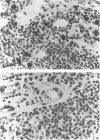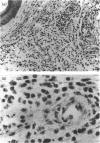Abstract
Using mast cell-deficient mutant W/Wv mice and their normal counterpart we re-evaluated the significance of participation of mast cells in allergic inflammatory response. W/Wv mice developed immediate hypersensitivity (IH) footpad reaction (FPR) to a somewhat lesser degree than the normal mice, suggesting that the mast cell might amplify the response. To exert classical tuberculin (tbc) delayed-type hypersensitivity (DTH) mast cells were not an essential cellular component. Vasoactive amines were essential to develop the response, but it did not necessarily originate from mast cells. When mice were immunized with methylated human serum albumin (MHSA) emulsified in incomplete Freund's adjuvant (IFA), mast cells were required to elicit DTH FPR. This was confirmed by the lack of the response in W/Wv mice, and the restoration of FPR by local transplantation of mature mast cells into mutant mice. This mast cell-dependent (MD) DTH was different from tbc DTH as follows: mast cell dependency, macrophage dependency as revealed by ferritin sensitivity, kinetics of sensitization, effect of host's age and histopathology. Thus we concluded that there are two types of DTH in mice; one is macrophage-dependent tbc and the other is mast cell-dependent DTH. The correspondence of the DTH to the Jones-Mote (JM) DTH is discussed, although the dominance of mast cells in MD DTH lesion was not observed.
Full text
PDF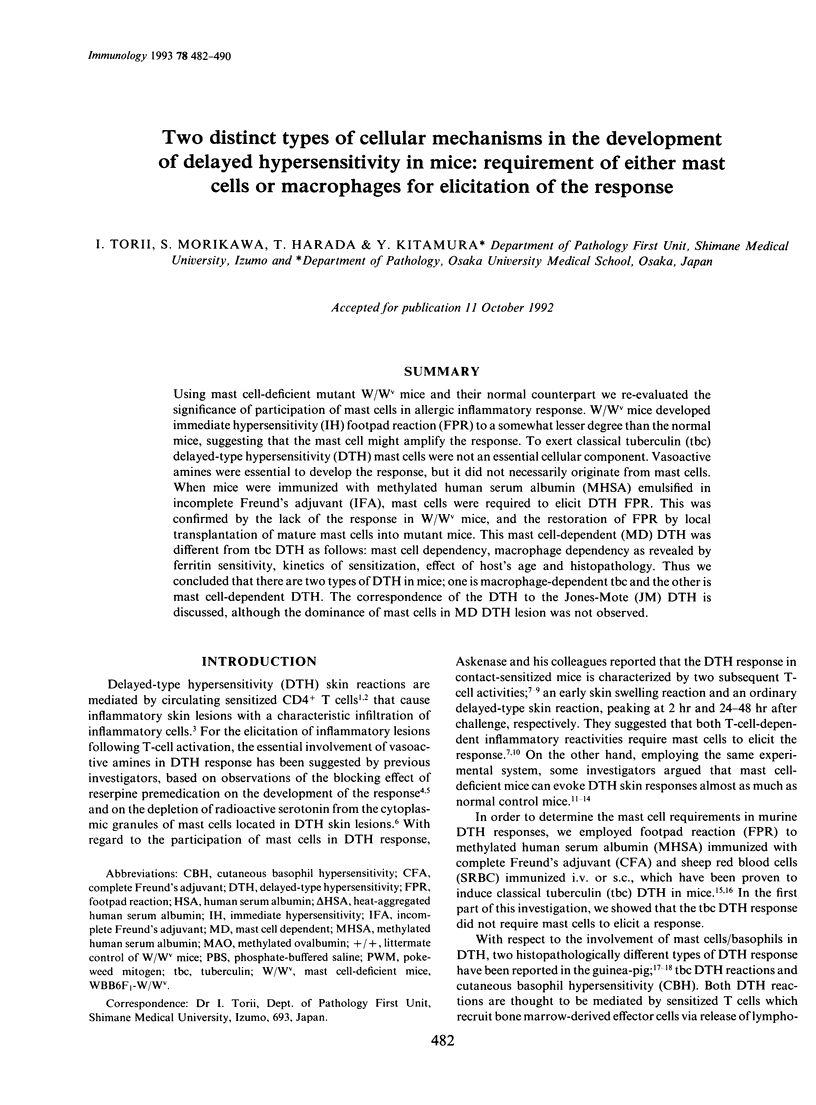
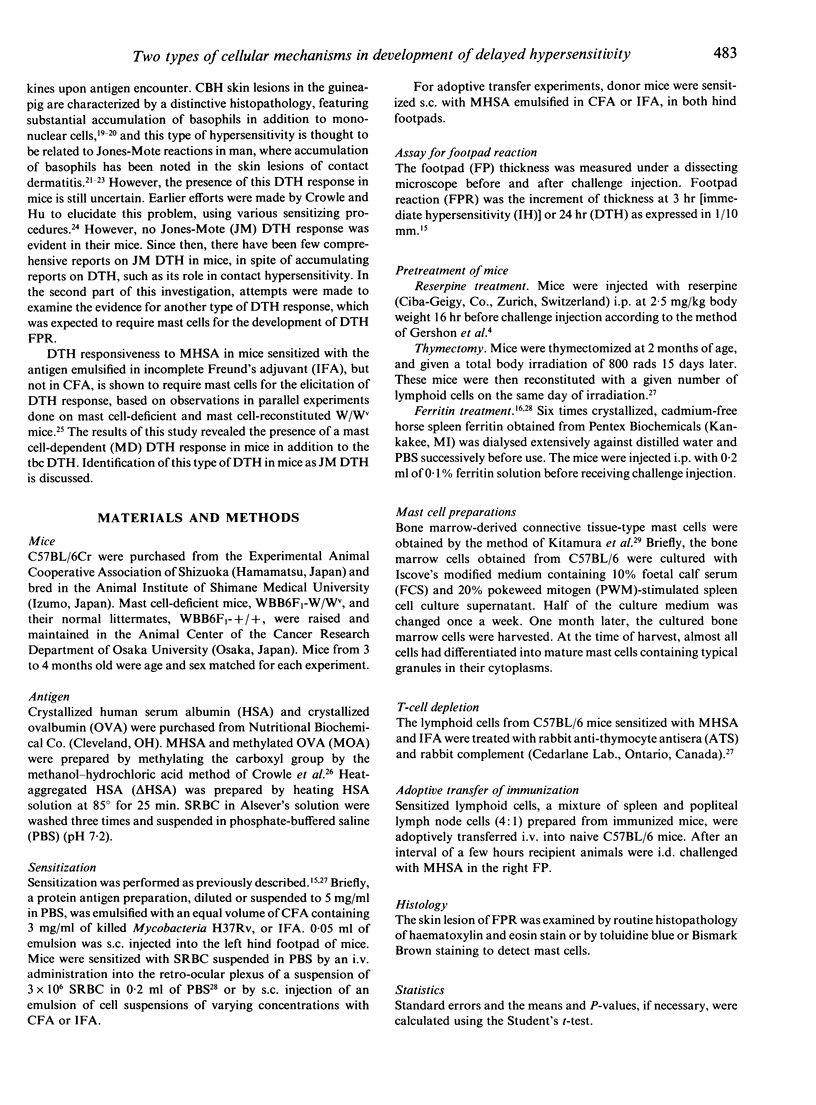
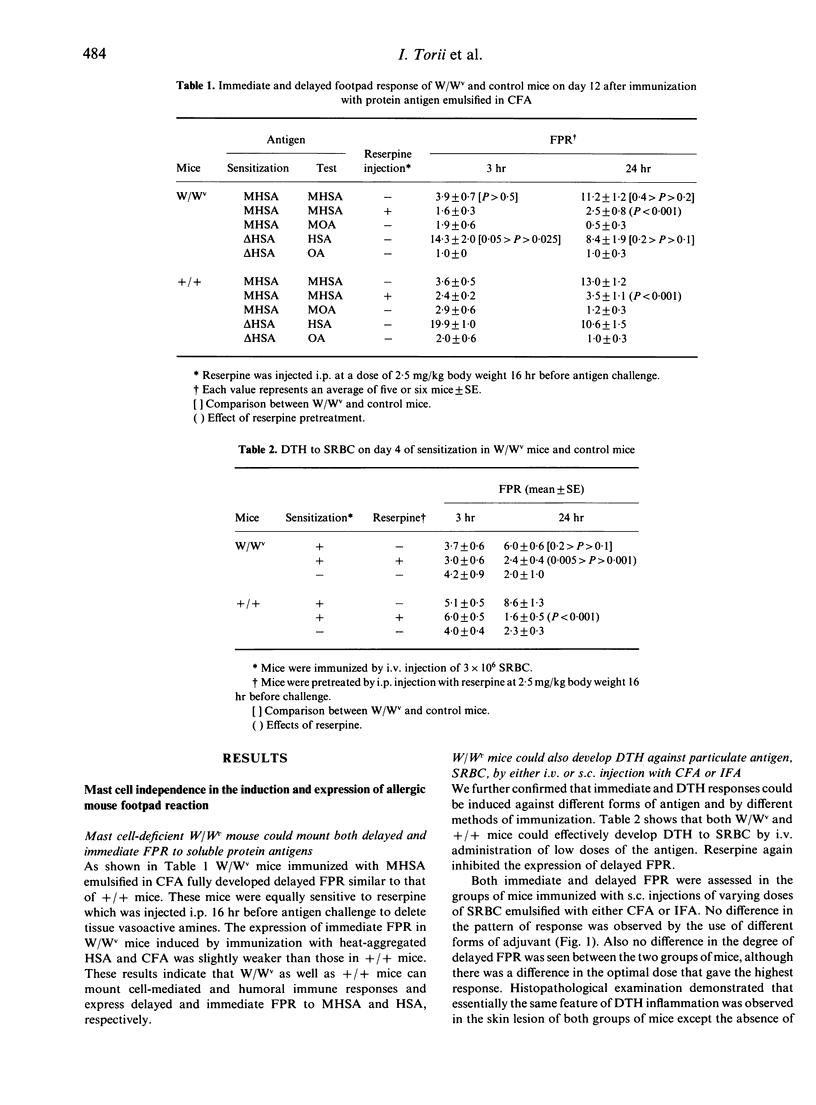
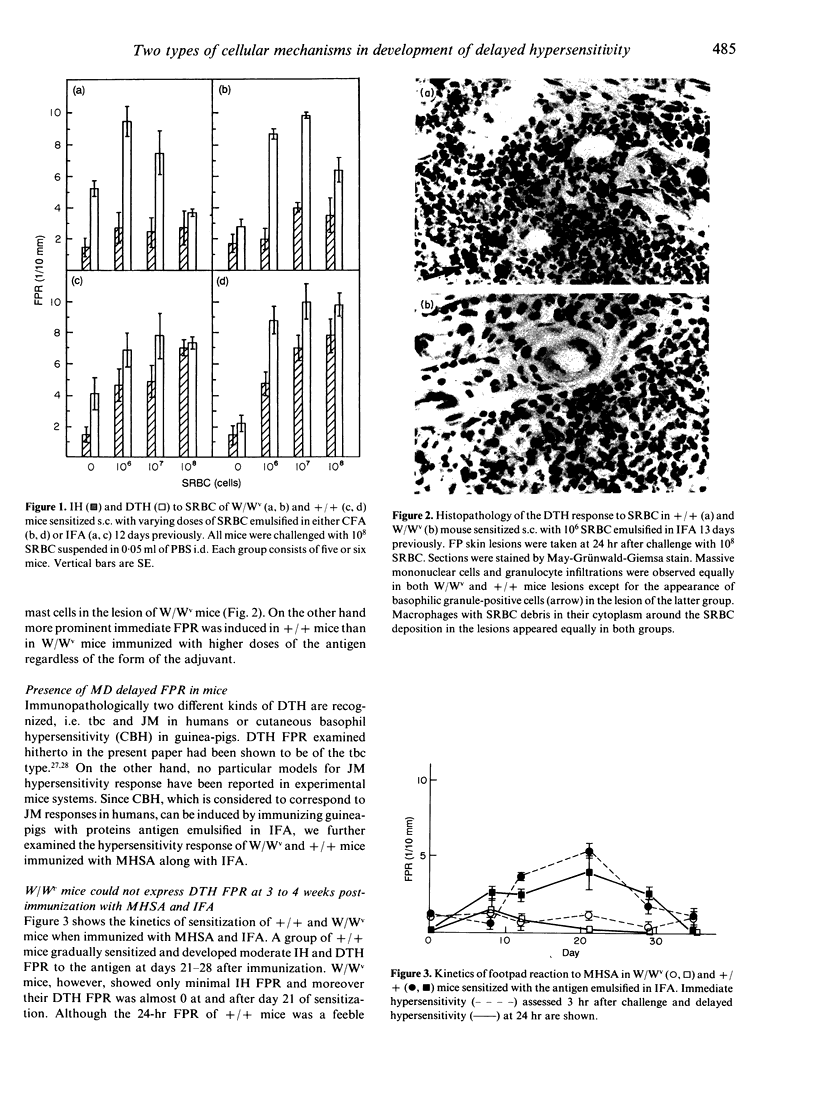
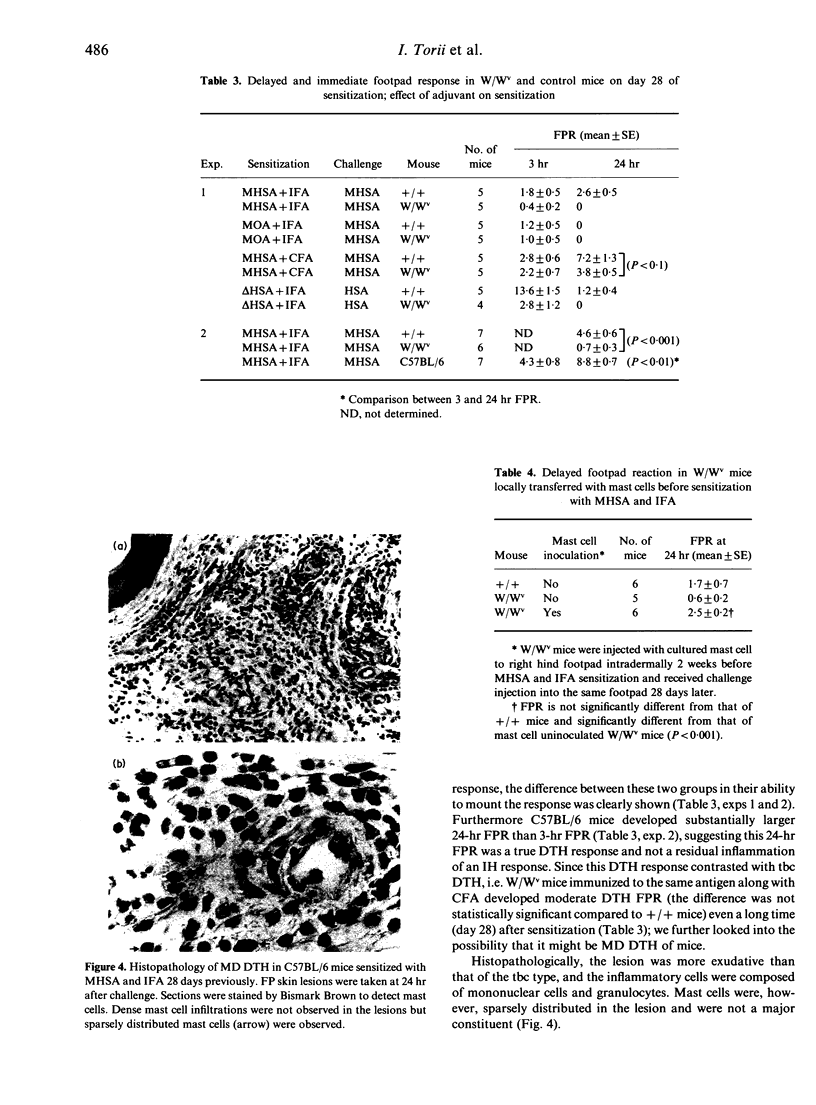
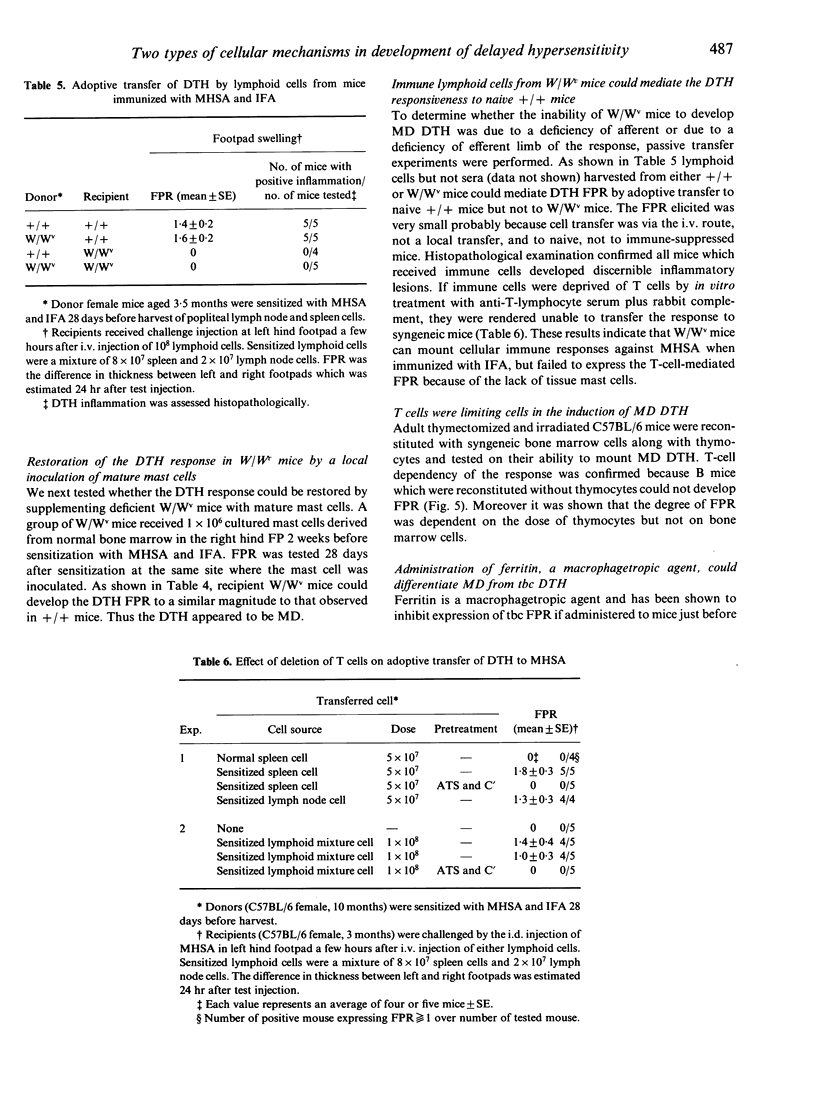
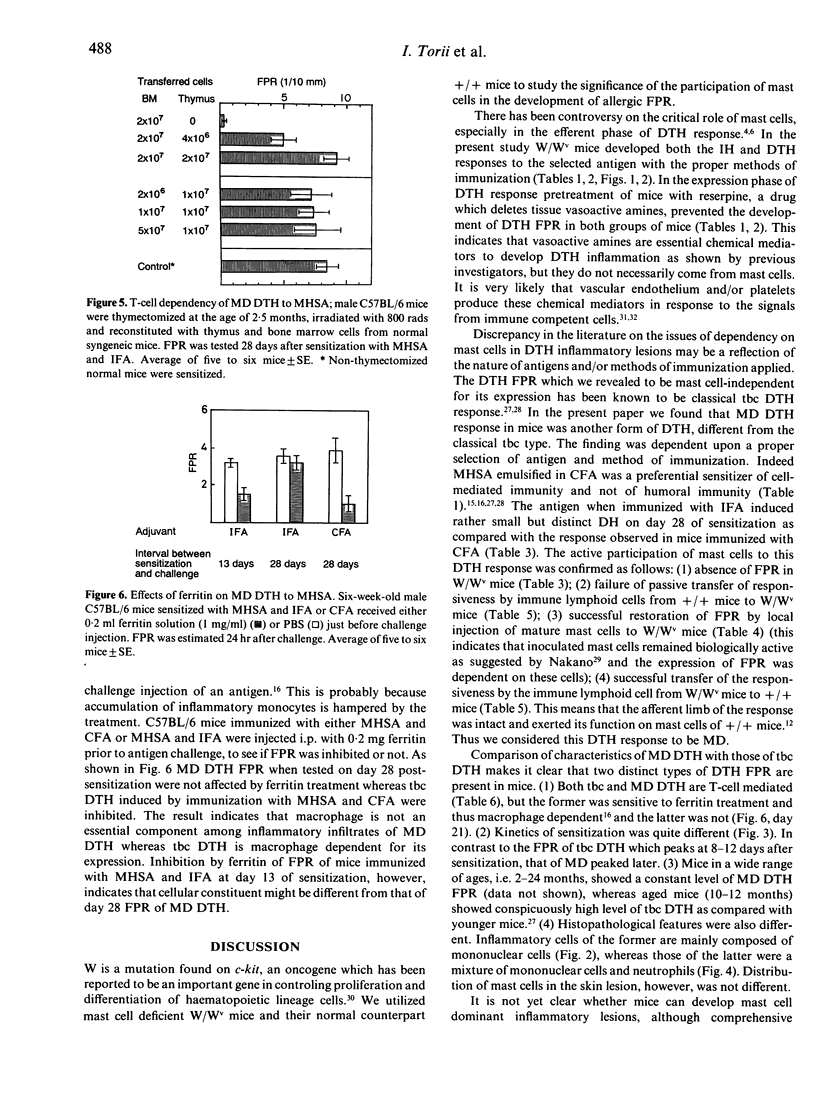
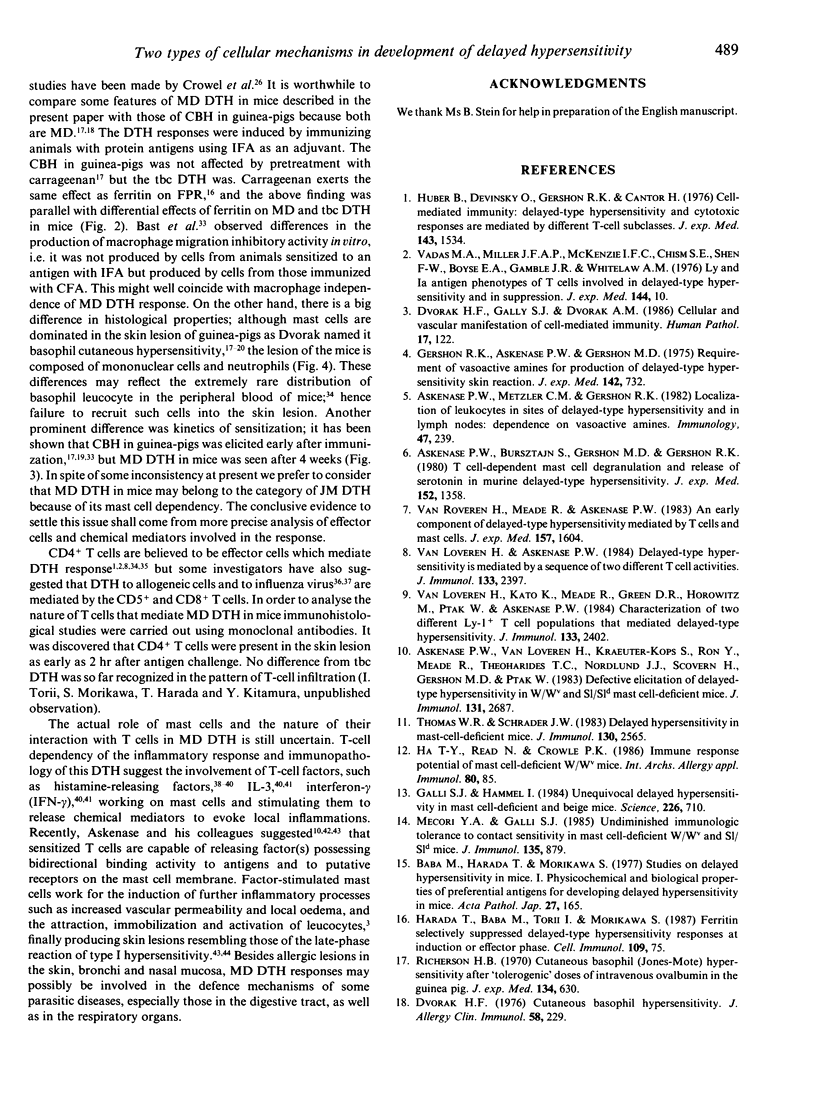
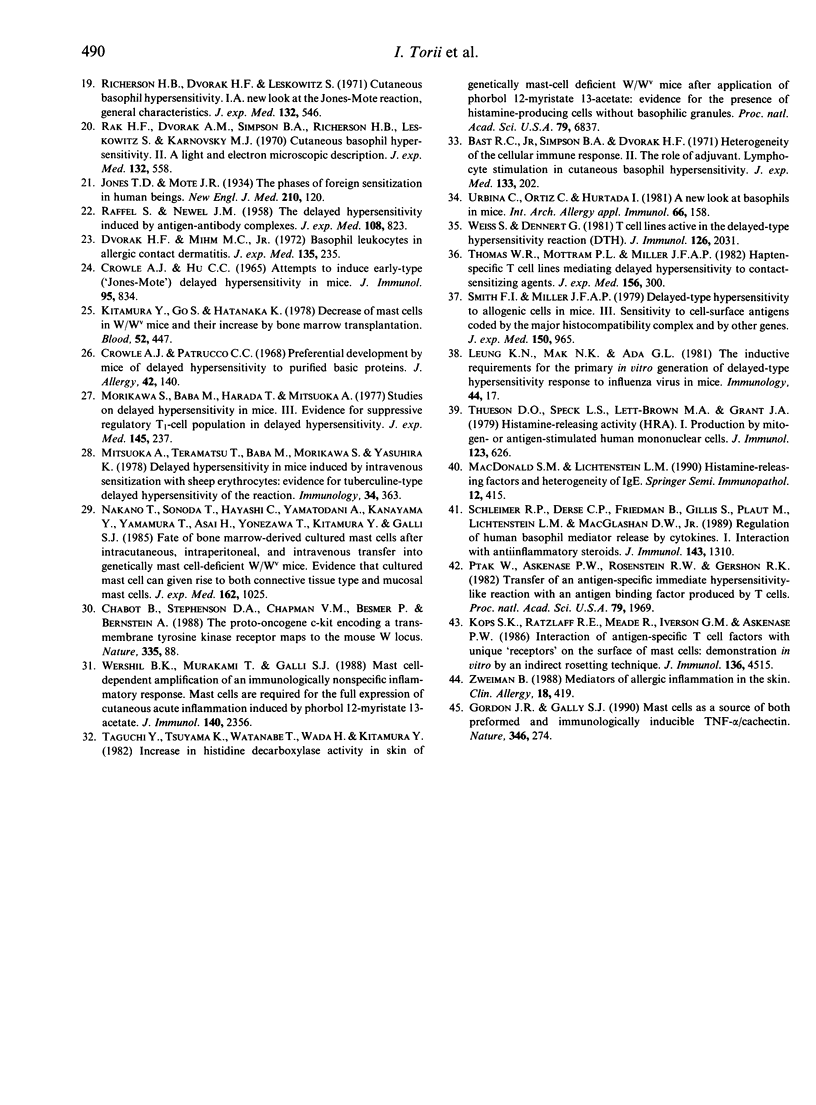
Images in this article
Selected References
These references are in PubMed. This may not be the complete list of references from this article.
- Askenase P. W., Bursztajn S., Gershon M. D., Gershon R. K. T cell-dependent mast cell degranulation and release of serotonin in murine delayed-type hypersensitivity. J Exp Med. 1980 Nov 1;152(5):1358–1374. doi: 10.1084/jem.152.5.1358. [DOI] [PMC free article] [PubMed] [Google Scholar]
- Askenase P. W., Metzler C. M., Gershon R. K. Localization of leucocytes in sites of delayed-type hypersensitivity and in lymph nodes: dependence on vasoactive amines. Immunology. 1982 Oct;47(2):239–246. [PMC free article] [PubMed] [Google Scholar]
- Askenase P. W., Van Loveren H., Kraeuter-Kops S., Ron Y., Meade R., Theoharides T. C., Nordlund J. J., Scovern H., Gerhson M. D., Ptak W. Defective elicitation of delayed-type hypersensitivity in W/Wv and SI/SId mast cell-deficient mice. J Immunol. 1983 Dec;131(6):2687–2694. [PubMed] [Google Scholar]
- Baba M., Harada T., Morikawa S. Studies on delayed hypersensitivity in mice. I, Physicochemical and biological properties of preferential antigens for inducing delayed hypersensitivity in mice. Acta Pathol Jpn. 1977 Mar;27(2):165–183. doi: 10.1111/j.1440-1827.1977.tb01867.x. [DOI] [PubMed] [Google Scholar]
- Bast R. C., Jr, Simpson B. A., Dvorak H. F. Heterogeneity of the cellular immune response. II. The role of adjuvant, lymphocyte stimulation in cutaneous basophil hypersensitivity. J Exp Med. 1971 Feb 1;133(2):202–215. doi: 10.1084/jem.133.2.202. [DOI] [PMC free article] [PubMed] [Google Scholar]
- Chabot B., Stephenson D. A., Chapman V. M., Besmer P., Bernstein A. The proto-oncogene c-kit encoding a transmembrane tyrosine kinase receptor maps to the mouse W locus. Nature. 1988 Sep 1;335(6185):88–89. doi: 10.1038/335088a0. [DOI] [PubMed] [Google Scholar]
- Crowle A. J., Hu C. C. Attempts to induce early-type ("Jones-Mote") delayed hypersensitivity in mice. J Immunol. 1965 Nov;95(5):834–839. [PubMed] [Google Scholar]
- Crowle A. J., Patrucco A. Preferential development by mice of delayed hypersensitivity to purified basic proteins. J Allergy. 1968 Sep;42(3):140–156. doi: 10.1016/0021-8707(68)90087-7. [DOI] [PubMed] [Google Scholar]
- Dvorak H. F. Cutaneous basophil hypersensitivity. J Allergy Clin Immunol. 1976 Jul;58(1 Pt 2):229–240. doi: 10.1016/0091-6749(76)90159-7. [DOI] [PubMed] [Google Scholar]
- Dvorak H. F., Dvorak A. M., Simpson B. A., Richerson H. B., Leskowitz S., Karnovsky M. J. Cutaneous basophil hypersensitivity. II. A light and electron microscopic description. J Exp Med. 1970 Sep 1;132(3):558–582. doi: 10.1084/jem.132.3.558. [DOI] [PMC free article] [PubMed] [Google Scholar]
- Dvorak H. F., Galli S. J., Dvorak A. M. Cellular and vascular manifestations of cell-mediated immunity. Hum Pathol. 1986 Feb;17(2):122–137. doi: 10.1016/s0046-8177(86)80285-4. [DOI] [PubMed] [Google Scholar]
- Dvorak H. F., Mihm M. C., Jr Basophilic leukocytes in allergic contact dermatitis. J Exp Med. 1972 Feb 1;135(2):235–254. doi: 10.1084/jem.135.2.235. [DOI] [PMC free article] [PubMed] [Google Scholar]
- Galli S. J., Hammel I. Unequivocal delayed hypersensitivity in mast cell-deficient and beige mice. Science. 1984 Nov 9;226(4675):710–713. doi: 10.1126/science.6494907. [DOI] [PubMed] [Google Scholar]
- Gershon R. K., Askenase P. W., Gershon M. D. Requirement for vasoactive amines for production of delayed-type hypersensitvity skin reactions. J Exp Med. 1975 Sep 1;142(3):732–747. doi: 10.1084/jem.142.3.732. [DOI] [PMC free article] [PubMed] [Google Scholar]
- Gordon J. R., Galli S. J. Mast cells as a source of both preformed and immunologically inducible TNF-alpha/cachectin. Nature. 1990 Jul 19;346(6281):274–276. doi: 10.1038/346274a0. [DOI] [PubMed] [Google Scholar]
- Ha T. Y., Reed N. D., Crowle P. K. Immune response potential of mast cell-deficient W/Wv mice. Int Arch Allergy Appl Immunol. 1986;80(1):85–94. doi: 10.1159/000234031. [DOI] [PubMed] [Google Scholar]
- Harada T., Baba M., Torii I., Morikawa S. Ferritin selectively suppresses delayed-type hypersensitivity responses at induction or effector phase. Cell Immunol. 1987 Oct 1;109(1):75–88. doi: 10.1016/0008-8749(87)90293-0. [DOI] [PubMed] [Google Scholar]
- Huber B., Devinsky O., Gershon R. K., Cantor H. Cell-mediated immunity: delayed-type hypersensitivity and cytotoxic responses are mediated by different T-cell subclasses. J Exp Med. 1976 Jun 1;143(6):1534–1539. doi: 10.1084/jem.143.6.1534. [DOI] [PMC free article] [PubMed] [Google Scholar]
- Kitamura Y., Go S., Hatanaka K. Decrease of mast cells in W/Wv mice and their increase by bone marrow transplantation. Blood. 1978 Aug;52(2):447–452. [PubMed] [Google Scholar]
- Kops S. K., Ratzlaff R. E., Meade R., Iverson G. M., Askenase P. W. Interaction of antigen-specific T cell factors with unique "receptors" on the surface of mast cells: demonstration in vitro by an indirect rosetting technique. J Immunol. 1986 Jun 15;136(12):4515–4524. [PubMed] [Google Scholar]
- Leung K. N., Mak N. K., Ada G. L. The inductive requirements for the primary in vitro generation of delayed-type hypersensitivity response to influenza virus in mice. Immunology. 1981 Sep;44(1):17–28. [PMC free article] [PubMed] [Google Scholar]
- MacDonald S. M., Lichtenstein L. M. Histamine-releasing factors and heterogeneity of IgE. Springer Semin Immunopathol. 1990;12(4):415–428. doi: 10.1007/BF00225327. [DOI] [PubMed] [Google Scholar]
- Mekori Y. A., Galli S. J. Undiminished immunologic tolerance to contact sensitivity in mast cell-deficient W/Wv and Sl/Sld mice. J Immunol. 1985 Aug;135(2):879–885. [PubMed] [Google Scholar]
- Mitsuoka A., Teramatsu T., Baba M., Morikawa S., Yasuhira K. Delayed hypersensitivity in mice induced by intravenous sensitization with sheep erythrocytes: evidence for tuberculin type delayed hypersensitivity of the reaction. Immunology. 1978 Mar;34(3):363–370. [PMC free article] [PubMed] [Google Scholar]
- Morikawa S., Baba M., Harada T., Mitsuoka A. Studies on delayed hypersensitivity in mice. III. Evidence for suppressive regulatory T1-cell population in delayed hypersensitivity. J Exp Med. 1977 Feb 1;145(2):237–248. doi: 10.1084/jem.145.2.237. [DOI] [PMC free article] [PubMed] [Google Scholar]
- Nakano T., Sonoda T., Hayashi C., Yamatodani A., Kanayama Y., Yamamura T., Asai H., Yonezawa T., Kitamura Y., Galli S. J. Fate of bone marrow-derived cultured mast cells after intracutaneous, intraperitoneal, and intravenous transfer into genetically mast cell-deficient W/Wv mice. Evidence that cultured mast cells can give rise to both connective tissue type and mucosal mast cells. J Exp Med. 1985 Sep 1;162(3):1025–1043. doi: 10.1084/jem.162.3.1025. [DOI] [PMC free article] [PubMed] [Google Scholar]
- Ptak W., Askenase P. W., Rosenstein R. W., Gershon R. K. Transfer of an antigen-specific immediate hypersensitivity-like reaction with an antigen-binding factor produced by T cells. Proc Natl Acad Sci U S A. 1982 Mar;79(6):1969–1973. doi: 10.1073/pnas.79.6.1969. [DOI] [PMC free article] [PubMed] [Google Scholar]
- RAFFEL S., NEWEL J. M. The delayed hypersensitivity induced by antigen-antibody complexes. J Exp Med. 1958 Dec 1;108(6):823–841. doi: 10.1084/jem.108.6.823. [DOI] [PMC free article] [PubMed] [Google Scholar]
- Richerson H. B. Cutaneous basophil (Jones-Mote) hypersensitivity after "tolerogenic" doses of intravenous ovalbumin in the guinea pig. J Exp Med. 1971 Sep 1;134(3 Pt 1):630–641. doi: 10.1084/jem.134.3.630. [DOI] [PMC free article] [PubMed] [Google Scholar]
- Richerson H. B., Dvorak H. F., Leskowitz S. Cutaneous basophil hypersensitivity. I. A new look at the Jones-Mote reaction, general characteristics. J Exp Med. 1970 Sep 1;132(3):546–557. doi: 10.1084/jem.132.3.546. [DOI] [PMC free article] [PubMed] [Google Scholar]
- Schleimer R. P., Derse C. P., Friedman B., Gillis S., Plaut M., Lichtenstein L. M., MacGlashan D. W., Jr Regulation of human basophil mediator release by cytokines. I. Interaction with antiinflammatory steroids. J Immunol. 1989 Aug 15;143(4):1310–1317. [PubMed] [Google Scholar]
- Smith F. I., Miller J. F. Delayed-type hypersensitivity to allogeneic cells in mice. III. Sensitivity to cell-surface antigens coded by the major histocompatibility complex and by other genes. J Exp Med. 1979 Oct 1;150(4):965–976. doi: 10.1084/jem.150.4.965. [DOI] [PMC free article] [PubMed] [Google Scholar]
- Taguchi Y., Tsuyama K., Watanabe T., Wada H., Kitamura Y. Increase in histidine decarboxylase activity in skin of genetically mast-cell-deficient W/Wv mice after application of phorbol 12-myristate 13-acetate: evidence for the presence of histamine-producing cells without basophilic granules. Proc Natl Acad Sci U S A. 1982 Nov;79(22):6837–6841. doi: 10.1073/pnas.79.22.6837. [DOI] [PMC free article] [PubMed] [Google Scholar]
- Thomas W. R., Mottram P. L., Miller J. F. Hapten-specific T cell lines mediating delayed hypersensitivity to contact-sensitizing agents. J Exp Med. 1982 Jul 1;156(1):300–305. doi: 10.1084/jem.156.1.300. [DOI] [PMC free article] [PubMed] [Google Scholar]
- Thomas W. R., Schrader J. W. Delayed hypersensitivity in mast-cell-deficient mice. J Immunol. 1983 Jun;130(6):2565–2567. [PubMed] [Google Scholar]
- Thueson D. O., Speck L. S., Lett-Brown M. A., Grant J. A. Histamine-releasing activity (HRA). I. Production by mitogen- or antigen-stimulated human mononuclear cells. J Immunol. 1979 Aug;123(2):626–632. [PubMed] [Google Scholar]
- Urbina C., Ortiz C., Hurtado I. A new look at basophils in mice. Int Arch Allergy Appl Immunol. 1981;66(2):158–160. doi: 10.1159/000232814. [DOI] [PubMed] [Google Scholar]
- Van Loveren H., Askenase P. W. Delayed-type hypersensitivity is mediated by a sequence of two different T cell activities. J Immunol. 1984 Nov;133(5):2397–2401. [PubMed] [Google Scholar]
- Van Loveren H., Kato K., Meade R., Green D. R., Horowitz M., Ptak W., Askenase P. W. Characterization of two different Ly-1+ T cell populations that mediate delayed-type hypersensitivity. J Immunol. 1984 Nov;133(5):2402–2411. [PubMed] [Google Scholar]
- Wershil B. K., Murakami T., Galli S. J. Mast cell-dependent amplification of an immunologically nonspecific inflammatory response. Mast cells are required for the full expression of cutaneous acute inflammation induced by phorbol 12-myristate 13-acetate. J Immunol. 1988 Apr 1;140(7):2356–2360. [PubMed] [Google Scholar]
- Zweiman B. Mediators of allergic inflammation in the skin. Clin Allergy. 1988 Sep;18(5):419–433. doi: 10.1111/j.1365-2222.1988.tb02892.x. [DOI] [PubMed] [Google Scholar]
- van Loveren H., Meade R., Askenase P. W. An early component of delayed-type hypersensitivity mediated by T cells and mast cells. J Exp Med. 1983 May 1;157(5):1604–1617. doi: 10.1084/jem.157.5.1604. [DOI] [PMC free article] [PubMed] [Google Scholar]



